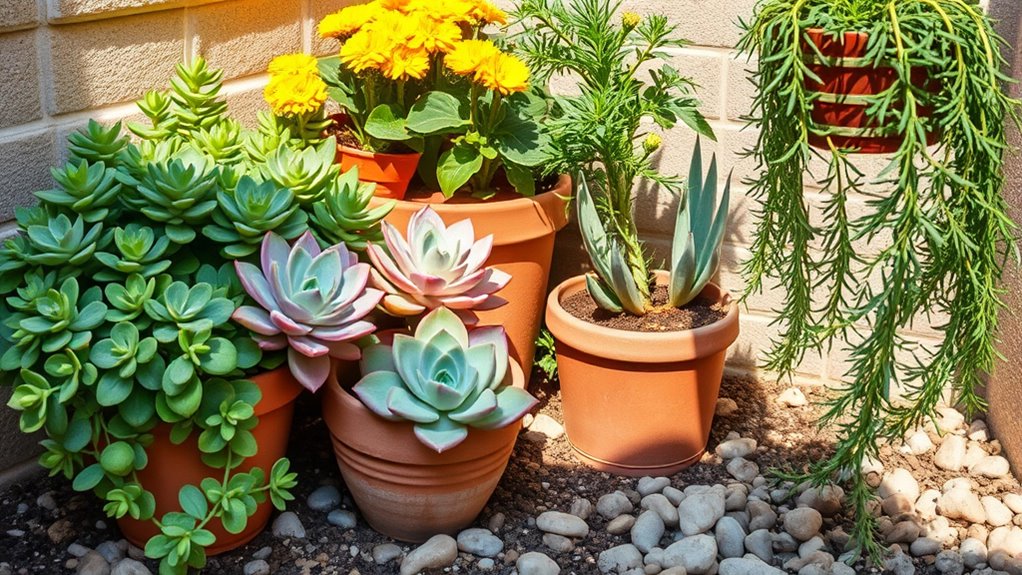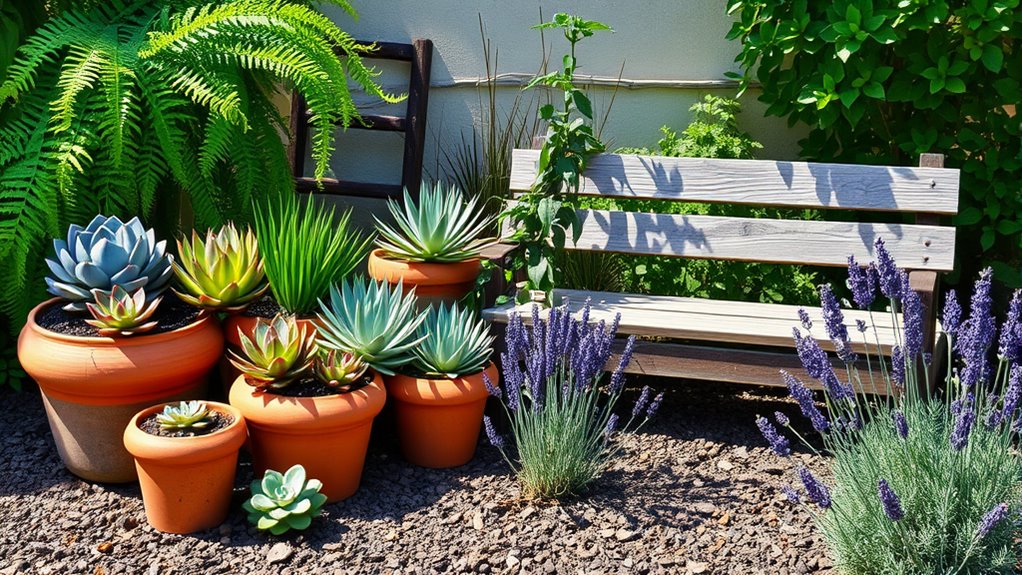If you’re a lazy gardener, you’ll love low-maintenance plants like coneflowers and peonies. They offer beautiful blooms without much effort. Hardy geraniums and black mondo grass also provide color and texture while requiring little care. For shade, sweetbay magnolias and inkberry hollies thrive in poor soil and need minimal attention. Use self-seeding annuals like cosmos for easy upkeep. Stick around to discover more tips on crafting a lush, effortless garden!
Key Takeaways
- Choose low-maintenance perennials like coneflower and peonies that thrive with minimal care and return year after year.
- Opt for shade-tolerant plants such as sweetbay magnolia and inkberry holly, which require little attention and thrive in poor soil.
- Incorporate self-seeding annuals like Barlow columbine and cosmos to ensure colorful blooms without replanting efforts.
- Use ground cover plants like black mondo grass and lambs ear to fill spaces while requiring minimal upkeep.
- Implement efficient watering solutions, such as grouping plants by water needs and mulching, to reduce watering frequency.

If you love the idea of a beautiful garden but dread the upkeep, you’re in luck. Embracing lazy gardening means selecting low-maintenance plants that thrive with minimal care.
Start by considering Coneflower (Echinacea), which isn’t only easy to grow but also attracts pollinators to your garden. These vibrant blooms return each year, bringing a splash of color without demanding your attention.
Pair them with Black Mondo Grass, which offers a striking contrast with its dark foliage. It’s perfect for filling in gaps and requires little to no maintenance.
Another great option for shaded areas is the Sweetbay Magnolia. This tree not only provides beautiful blossoms but also thrives in poor soil conditions. It’s an excellent choice if you’re looking to add some height and elegance to your garden without the need for constant care.
Combine this with Inkberry Holly, a hardy shrub that’s both deer-resistant and low-maintenance, keeping your garden intact and looking great throughout the seasons.
If you’re drawn to perennials that require minimal effort, consider Peonies and Hardy Geraniums. They offer stunning blooms that require very little attention.
Once planted, they’ll reward you with their beauty year after year, making them a gardener’s dream. These plants are resilient and can handle various environmental conditions while still delivering a beautiful display.
For an even more carefree approach, explore self-seeding annuals like Barlow Columbine and Cosmos. These plants will replant themselves, eliminating the need for you to worry about replanting each year.
Just imagine enjoying a vibrant garden filled with colorful blooms that require minimal input from you.
Additionally, incorporating plants like Lambs Ear and Mint can significantly enhance your garden’s aesthetics while minimizing maintenance needs. They thrive in poor soil and require minimal watering, making them perfect companions for your low-effort gardening strategy.
A simple watering system can help ensure they stay hydrated without the hassle of daily watering.
Frequently Asked Questions
What Is the Best Outdoor Plant for Lazy People?
If you’re looking for the best outdoor plant for lazy people, consider the Sweetbay Magnolia. It thrives in part shade and moist, acidic soil, needing very little maintenance. You won’t have to worry about constant care or upkeep.
Another great option is the Coneflower, which offers vibrant blooms and is drought-tolerant once established. Both plants allow you to enjoy a beautiful garden without the hassle, freeing up your time for other activities.
What Plant Needs the Least Amount of Care?
If you’re looking for a plant that practically raises itself, you might want to consider the Texas Ranger.
It only needs a sip of water during droughts, and it dazzles with color while you do absolutely nothing.
Or maybe you’d prefer daffodils, which pop up and bloom like they own the place, requiring little more than decent soil.
What Is the Gardening 3 Year Rule?
The Gardening 3 Year Rule suggests you give your plants three years to establish themselves before making any decisions about their success.
In the first year, they focus on developing roots. By the second year, you’ll see more foliage, and in the third year, they should start blooming or producing fruit.
Patience is key here; waiting allows your plants to acclimate and thrive, leading to a lush and vibrant garden.
What Is the Rule of 3 in Landscaping?
The Rule of 3 in landscaping suggests that you group plants in threes to create a balanced and visually appealing design.
By repeating plant types, colors, or textures, you simplify your planting decisions and enhance the overall look of your garden. This approach also helps with spacing and maintenance, making it easier for you to care for your plants.
Plus, layering different heights in groups of three adds depth and interest to your landscape.
Conclusion
In the world of gardening, embracing the art of effortless beauty can be your secret to success. By choosing resilient, low-maintenance plants, you’ll cultivate a thriving oasis without the fuss. Think of it as giving yourself a well-deserved break while still enjoying the fruits of your labor. So, let your garden flourish with minimal effort—after all, it’s about enjoying nature’s gifts without the heavy lifting. Embrace the bliss of a carefree garden, and watch it thrive!









